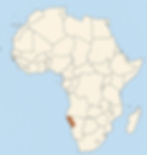


The Himba people are an indigenous group in northwestern Namibia, known for their semi-nomadic pastoralist lifestyle and distinct cultural traditions. Today, there are around 50,000 Himba people left, and they primarily live in the Kunene Region, near the border with Angola, where the terrain is arid and rugged. Traditionally, the Himba rely on cattle herding as the core of their economy and identity, with livestock playing a central role in their spiritual life, social status, and diet. They speak Otjihimba, which is a dialect of the Herero language in the Bantu family. Despite the isolation of their homeland, the Himba face increasing pressures from climate change, land disputes, and modernity, all of which threaten their traditional ways of life.

One of the most unique and recognizable aspects of Himba culture is their hair, which serves as a powerful symbol of identity, age, and social status. Each stage of life is marked with a distinct hairstyle. Young girls typically wear two forward-facing braids called ozondato, while boys often have a single braid if they are not yet circumcised. As girls mature, their hair is styled into thick dreadlocks covered in otjize which is a mixture of red ochre, butterfat, and herbs that protects them from the harsh desert climate and gives their hair its signature reddish hue. Married women often wear more elaborate styles, sometimes adorned with goat-hair extensions and ornaments. Men usually shave their heads after marriage and wear a headpiece called the erembe.

Himba homes are small, round huts that are primarily built by women. The walls are made from a mixture of earth and cow dung, creating a smooth, clay-like surface that helps insulate against the extreme desert temperatures. The tall roof is thatched with dried grass, designed to shed rain and provide shade from the intense sun. Entrances are low and narrow, helping to retain warmth during cold nights and block out wind and dust during the day. These huts are arranged in family compounds, with each one assigned based on age, gender, and social role. For example, unmarried girls and boys may sleep separately, while married couples have their own hut.

Rising temperatures and unpredictable rainfall have made water and grazing lands scarce for the Himba people, threatening their traditional way of life. Droughts last longer and grow more severe, causing livestock to weaken or die, which undermines their main source of food and income. As climate change intensifies, the Himba struggle to maintain both their livelihoods and their cultural identity.

Ultimately, the Himba are a remarkable group of people who have managed to thrive in Namibia’s arid landscapes for generations. Despite the challenges they face from climate change, they continue to show resilience by adapting to shifting conditions while striving to preserve their traditions, culture, and connection to their ancestral lands.




Truly fascinating.
Great so inspirational!!! 😍